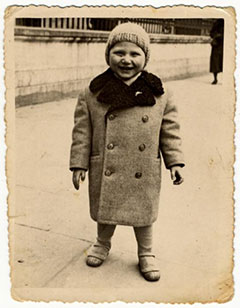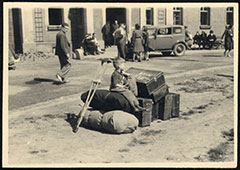August 22nd, 2019
Introduction
 Photograph of Dawid Samoszul. Close-up street portrait of Dawid Samoszul, probably taken in Piotrkow Trybunalski, Poland, between 1936 and 1938. Dawid was killed in the Treblinka killing center at the age of 9. US Holocaust Memorial Museum, courtesy of Abe Samelson
Photograph of Dawid Samoszul. Close-up street portrait of Dawid Samoszul, probably taken in Piotrkow Trybunalski, Poland, between 1936 and 1938. Dawid was killed in the Treblinka killing center at the age of 9. US Holocaust Memorial Museum, courtesy of Abe Samelson
The Holocaust was the systematic, state-sponsored persecution and murder of six million Jews by the Nazi regime and its allies and collaborators. Holocaust is a word of Greek origin meaning "sacrifice by fire." The Nazis, who came to power in Germany in January 1933, believed that Germans were "racially superior" and that the Jews, deemed "inferior," were an alien threat to the so-called German racial community.
During the era of the Holocaust, German authorities also targeted other groups because of their perceived racial and biological inferiority: Roma (Gypsies), people with disabilities, some of the Slavic peoples (Poles, Russians, and others), Soviet prisoners of war, and blacks. Other groups were persecuted on political, ideological, and behavioral grounds, among them Communists, Socialists, Jehovah's Witnesses, and homosexuals.
What Was the Holocaust?
In 1933, the Jewish population of Europe stood at over nine million. Most European Jews lived in countries that Nazi Germany would occupy or influence during World War II. By the end of the war in 1945, the Germans and their allies and collaborators killed nearly two out of every three European Jews as part of the "Final Solution."
The Nazis considered Jews to be the inferior race that posed the deadliest menace to the German Volk. Soon after they came to power, the Nazis adopted measures to exclude Jews from German economic, social and cultural life and to pressure them to emigrate. World War II provided Nazi officials with the opportunity to pursue a comprehensive, “final solution to the Jewish questionâ€: the murder of all the Jews in Europe.
While Jews were the priority target of Nazi racism, other groups within Germany were persecuted for racial reasons, including Roma (then commonly called "Gypsies"), Afro-Germans, and people with mental or physical disabilities. By the end of the war, the Germans and their Axis partners murdered up to 250,000 Roma. And between 1939 and 1945, they murdered at least 250,000 mentally or physically disabled patients, mainly German and living in institutions, in the so-called Euthanasia Program.
As Nazi tyranny spread across Europe, the Germans and their collaborators persecuted and murdered millions of other people seen as biologically inferior or dangerous. Between two and three million Soviet prisoners of war, viewed by the Nazis as the biological "carriers" of Bolshevism, were murdered or died of starvation, disease, neglect, or brutal treatment. The Germans shot tens of thousands of non-Jewish members of the Polish intelligentsia, murdered the inhabitants of hundreds of villages in “pacification†raids in Poland and the Soviet Union, and deported millions of Polish and Soviet civilians to perform forced labor under conditions that caused many to die.
From the earliest years of the Nazi regime, German authorities persecuted homosexuals and other Germans whose behavior did conform to prescribed social norms (such as beggars, alcoholics, and prostitutes), incarcerating thousands of them in prisons and concentration camps. German police officials similarly persecuted thousands of Germans viewed as political opponents (including Communists, Socialists, Freemasons, and trade unionists) and religious dissidents (such as Jehovah's Witnesses). Many of these individuals died as a result of maltreatment and murder.
Administration of the "Final Solution"
In the early years of the Nazi regime, the National Socialist government established concentration camps to detain real and imagined political and ideological opponents. Increasingly in the years before the outbreak of war, SS and police officials incarcerated Jews, Roma, and other victims of ethnic and racial hatred in these camps.
To concentrate and monitor the Jewish population as well as to facilitate later deportation of the Jews, the Germans and their collaborators created ghettos, transit camps, and forced-labor camps for Jews during the war years. The German authorities also established numerous forced-labor camps, both in the so-called Greater German Reich and in German-occupied territory, for non-Jews whose labor the Germans sought to exploit.
Following the invasion of the Soviet Union in June 1941, Einsatzgruppen and, later, militarized battalions of Order Police officials, moved behind German lines to carry out mass-murder operations against Jews, Roma, and Soviet state and Communist Party officials. German SS and police units, supported by units of the Wehrmacht and the Waffen SS, murdered more than a million Jewish men, women, and children, and hundreds of thousands of others.
Between 1941 and 1944, Nazi German authorities deported millions of Jews from Germany, from occupied territories, and from the countries of many of its Axis allies to ghettos and to killing centers, often called extermination camps, where they were murdered in specially developed gassing facilities.
My mother ran over to me and grabbed me by the shoulders, and she told me "Leibele, I'm not going to see you no more. Take care of your brother."
—Leo Schneiderman describing arrival at Auschwitz, selection, and separation from his family
The End of the Holocaust
In the final months of the war, SS guards moved camp inmates by train or on forced marches, often called “death marches,†in an attempt to prevent the Allied liberation of large numbers of prisoners. As Allied forces moved across Europe in a series of offensives against Germany, they began to encounter and liberate concentration camp prisoners, as well as prisoners en route by forced march from one camp to another. The marches continued until May 7, 1945, the day the German armed forces surrendered unconditionally to the Allies.
For the Western Allies, World War II officially ended in Europe on the next day, May 8 (V-E Day), while Soviet forces announced their “Victory Day†on May 9, 1945.
In the aftermath of the Holocaust, more than 250,000 survivors found shelter in displaced persons camps run by the Allied powers and the United Nations Refugee and Rehabilitation Administration in Germany, Austria, and Italy. Between 1948 and 1951, 136,000 Jewish displaced persons immigrated to Israel, while others resettled in the United States and other nations outside Europe. Other Jewish displaced persons emigrated to the United States and other nations. The last camp for Jewish displaced persons closed in 1957.
 A child waiting to leave the Deggendorf displaced persons camp. A young child sits among luggage while waiting to depart the Deggendorf displaced persons camp. Deggendorf, Germany, 1945-46. US Holocaust Memorial Museum, courtesy of Marion House
A child waiting to leave the Deggendorf displaced persons camp. A young child sits among luggage while waiting to depart the Deggendorf displaced persons camp. Deggendorf, Germany, 1945-46. US Holocaust Memorial Museum, courtesy of Marion House
The crimes committed during the Holocaust devastated most European Jewish communities and eliminated hundreds of Jewish communities in occupied eastern Europe entirely.
Editor's Note: For more information on this atrocity, please visit https://encyclopedia.ushmm.org/content/en/article/introduction-to-the-holocaust back...
 Photograph of Dawid Samoszul. Close-up street portrait of Dawid Samoszul, probably taken in Piotrkow Trybunalski, Poland, between 1936 and 1938. Dawid was killed in the Treblinka killing center at the age of 9. US Holocaust Memorial Museum, courtesy of Abe Samelson
Photograph of Dawid Samoszul. Close-up street portrait of Dawid Samoszul, probably taken in Piotrkow Trybunalski, Poland, between 1936 and 1938. Dawid was killed in the Treblinka killing center at the age of 9. US Holocaust Memorial Museum, courtesy of Abe SamelsonThe Holocaust was the systematic, state-sponsored persecution and murder of six million Jews by the Nazi regime and its allies and collaborators. Holocaust is a word of Greek origin meaning "sacrifice by fire." The Nazis, who came to power in Germany in January 1933, believed that Germans were "racially superior" and that the Jews, deemed "inferior," were an alien threat to the so-called German racial community.
During the era of the Holocaust, German authorities also targeted other groups because of their perceived racial and biological inferiority: Roma (Gypsies), people with disabilities, some of the Slavic peoples (Poles, Russians, and others), Soviet prisoners of war, and blacks. Other groups were persecuted on political, ideological, and behavioral grounds, among them Communists, Socialists, Jehovah's Witnesses, and homosexuals.
What Was the Holocaust?
In 1933, the Jewish population of Europe stood at over nine million. Most European Jews lived in countries that Nazi Germany would occupy or influence during World War II. By the end of the war in 1945, the Germans and their allies and collaborators killed nearly two out of every three European Jews as part of the "Final Solution."
The Nazis considered Jews to be the inferior race that posed the deadliest menace to the German Volk. Soon after they came to power, the Nazis adopted measures to exclude Jews from German economic, social and cultural life and to pressure them to emigrate. World War II provided Nazi officials with the opportunity to pursue a comprehensive, “final solution to the Jewish questionâ€: the murder of all the Jews in Europe.
While Jews were the priority target of Nazi racism, other groups within Germany were persecuted for racial reasons, including Roma (then commonly called "Gypsies"), Afro-Germans, and people with mental or physical disabilities. By the end of the war, the Germans and their Axis partners murdered up to 250,000 Roma. And between 1939 and 1945, they murdered at least 250,000 mentally or physically disabled patients, mainly German and living in institutions, in the so-called Euthanasia Program.
As Nazi tyranny spread across Europe, the Germans and their collaborators persecuted and murdered millions of other people seen as biologically inferior or dangerous. Between two and three million Soviet prisoners of war, viewed by the Nazis as the biological "carriers" of Bolshevism, were murdered or died of starvation, disease, neglect, or brutal treatment. The Germans shot tens of thousands of non-Jewish members of the Polish intelligentsia, murdered the inhabitants of hundreds of villages in “pacification†raids in Poland and the Soviet Union, and deported millions of Polish and Soviet civilians to perform forced labor under conditions that caused many to die.
From the earliest years of the Nazi regime, German authorities persecuted homosexuals and other Germans whose behavior did conform to prescribed social norms (such as beggars, alcoholics, and prostitutes), incarcerating thousands of them in prisons and concentration camps. German police officials similarly persecuted thousands of Germans viewed as political opponents (including Communists, Socialists, Freemasons, and trade unionists) and religious dissidents (such as Jehovah's Witnesses). Many of these individuals died as a result of maltreatment and murder.
Administration of the "Final Solution"
In the early years of the Nazi regime, the National Socialist government established concentration camps to detain real and imagined political and ideological opponents. Increasingly in the years before the outbreak of war, SS and police officials incarcerated Jews, Roma, and other victims of ethnic and racial hatred in these camps.
To concentrate and monitor the Jewish population as well as to facilitate later deportation of the Jews, the Germans and their collaborators created ghettos, transit camps, and forced-labor camps for Jews during the war years. The German authorities also established numerous forced-labor camps, both in the so-called Greater German Reich and in German-occupied territory, for non-Jews whose labor the Germans sought to exploit.
Following the invasion of the Soviet Union in June 1941, Einsatzgruppen and, later, militarized battalions of Order Police officials, moved behind German lines to carry out mass-murder operations against Jews, Roma, and Soviet state and Communist Party officials. German SS and police units, supported by units of the Wehrmacht and the Waffen SS, murdered more than a million Jewish men, women, and children, and hundreds of thousands of others.
Between 1941 and 1944, Nazi German authorities deported millions of Jews from Germany, from occupied territories, and from the countries of many of its Axis allies to ghettos and to killing centers, often called extermination camps, where they were murdered in specially developed gassing facilities.
My mother ran over to me and grabbed me by the shoulders, and she told me "Leibele, I'm not going to see you no more. Take care of your brother."
—Leo Schneiderman describing arrival at Auschwitz, selection, and separation from his family
The End of the Holocaust
In the final months of the war, SS guards moved camp inmates by train or on forced marches, often called “death marches,†in an attempt to prevent the Allied liberation of large numbers of prisoners. As Allied forces moved across Europe in a series of offensives against Germany, they began to encounter and liberate concentration camp prisoners, as well as prisoners en route by forced march from one camp to another. The marches continued until May 7, 1945, the day the German armed forces surrendered unconditionally to the Allies.
For the Western Allies, World War II officially ended in Europe on the next day, May 8 (V-E Day), while Soviet forces announced their “Victory Day†on May 9, 1945.
In the aftermath of the Holocaust, more than 250,000 survivors found shelter in displaced persons camps run by the Allied powers and the United Nations Refugee and Rehabilitation Administration in Germany, Austria, and Italy. Between 1948 and 1951, 136,000 Jewish displaced persons immigrated to Israel, while others resettled in the United States and other nations outside Europe. Other Jewish displaced persons emigrated to the United States and other nations. The last camp for Jewish displaced persons closed in 1957.
 A child waiting to leave the Deggendorf displaced persons camp. A young child sits among luggage while waiting to depart the Deggendorf displaced persons camp. Deggendorf, Germany, 1945-46. US Holocaust Memorial Museum, courtesy of Marion House
A child waiting to leave the Deggendorf displaced persons camp. A young child sits among luggage while waiting to depart the Deggendorf displaced persons camp. Deggendorf, Germany, 1945-46. US Holocaust Memorial Museum, courtesy of Marion HouseThe crimes committed during the Holocaust devastated most European Jewish communities and eliminated hundreds of Jewish communities in occupied eastern Europe entirely.
Editor's Note: For more information on this atrocity, please visit https://encyclopedia.ushmm.org/content/en/article/introduction-to-the-holocaust back...

